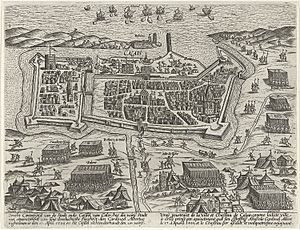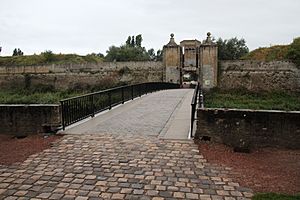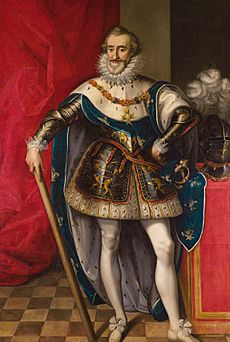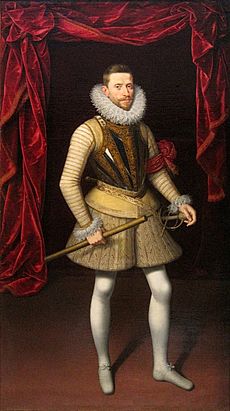Siege of Calais (1596) facts for kids
Quick facts for kids Siege of Calais (1596) |
|||||||
|---|---|---|---|---|---|---|---|
| Part of the Franco-Spanish War (1595–1598) and the Anglo-Spanish War (1585–1604) | |||||||
 Engraving the Siege of Calais of 1596 – collection Rijksmuseum Amsterdam |
|||||||
|
|||||||
| Belligerents | |||||||
Supported by: |
|||||||
| Commanders and leaders | |||||||
| Strength | |||||||
| Calais: About 7,000 men Relief forces: Unknown |
12,000–15,000 | ||||||
| Casualties and losses | |||||||
| Thousands of dead or prisoners 5,000 dead |
Low | ||||||
The Siege of Calais of 1596 was a major battle that took place in the important port city of Calais, France. It happened between April 8 and April 24, 1596. This event was part of several larger conflicts, including the Franco-Spanish War (1595–1598), the French Wars of Religion, and the Anglo-Spanish War (1585–1604). The battle ended with a victory for the Spanish forces. The Spanish Army of Flanders, led by Archduke Albert of Austria, captured the city. French troops held out in the citadel for a few more days. But on April 24, Spanish soldiers, led by Don Luis de Velasco, attacked and took the fortress. This win was the first big success for Archduke Albert's army in 1596.
Contents
Why Was Calais Attacked?
Since 1562, France had been fighting the French Wars of Religion. In these wars, Spain often helped the Catholic League in France. Spain had helped in battles like the Siege of Paris in 1590.
In 1595, the new French King, Henry IV of France, officially declared war on Spain. Henry IV had recently become a Catholic and was crowned king. He was trying to take back parts of northern France from Spanish and French Catholic forces.
In 1595, the Spanish army, led by Don Pedro Henríquez de Acevedo, captured many French towns. In the spring of 1596, King Henry IV's army was trying to capture La Fère, a town held by the Catholic League.
Philip II of Spain sent Archduke Albert to lead the Spanish Netherlands. Albert arrived in Brussels in February 1596. His main goal was to deal with King Henry IV of France. Instead of sending his army to help at La Fère, Albert decided to attack Calais. His army reached Calais on April 8.
The Siege of Calais Begins

The Spanish army, led by Archduke Albert, completely surprised the French troops in Calais. King Henry IV was busy trying to capture La Fère. He could not send any soldiers to help Calais.
His allies, England and the Dutch Republic, were too slow to react. Queen Elizabeth of England offered to send soldiers. But she wanted Calais to become English again after the battle. While the two leaders argued, the Spanish army worked quickly. This made it impossible for the English to help.
Meanwhile, Maurice of Nassau, Prince of Orange from the Dutch Republic tried to get a relief army ready. He also prepared a fleet of ships. But Calais fell on the very day the first Dutch ships were about to sail.
The City Falls
The main city of Calais fell to the Spanish after ten days of fighting. Only the citadel, a strong fortress, remained in French hands.
A French general, François d'Orléans-Longueville, tried to help the city by sea. He wanted to bring supplies and fresh soldiers. But Spanish cannons stopped his ships.
King Henry IV knew how important Calais was. It was one of France's most important port cities. Calais had been captured by England in 1347 during the Hundred Years' War. It stayed English until France took it back in 1558. Henry IV tried to march his army to Calais to help.
The Citadel is Captured

On April 24, Spanish troops, led by Don Luis de Velasco, attacked the citadel. The French soldiers fought bravely. But they could not defeat the skilled Spanish and Walloon (from what is now Belgium) attackers.
Thousands of French soldiers were killed or captured. The Spanish lost about 200 soldiers. The French Governor of Calais, Sieur de Widessan, was executed. The Spanish found a lot of valuable items in the citadel. This included gold, silver, horses, gunpowder, and supplies. With the citadel captured, the whole city of Calais was now under Spanish control. King Henry IV's hopes of keeping the city were gone.
What Happened Next?

The Spanish army's capture of Calais was a big victory. It was a serious setback for King Henry IV and his allies. Calais was very important because it gave Spain a great port to control the English Channel. Spain already controlled Dunkirk nearby.
After leaving soldiers in Calais, Archduke Albert moved his army to the nearby stronghold of Ardres. The French defenders there fought hard. But on May 23, they had to surrender to the stronger Spanish forces.
The day before Ardres fell, King Henry IV's troops finally captured La Fère. The Spanish and Catholic troops there surrendered honorably. Archduke Albert's next target was Hulst, a town on the Dutch front. In July, the attack on Hulst began. Just over a month later, Hulst also surrendered to the Spanish. This happened despite efforts by Prince Maurice of Nassau to help the city.
Calais remained under Spanish control for two years. In 1598, it was given back to France as part of the Peace of Vervins.
See also
 In Spanish: Asedio de Calais (1596) para niños
In Spanish: Asedio de Calais (1596) para niños


